Fifty years have come and gone since 1968. We can only say that for another few days, so now is the time!
1968 was chaotic and tumultuous and it seemed at times that things were falling apart because the center could not hold. It felt as it anarchy was loosed on the world and the blood-dimmed tide and the hour of the rough beast were loosed. Remember these highlights: North Korea seizing the U.S.S. Pueblo, the Tet offensive, My Lai, the Orange massacre (the killing of three protesters by South Carolina Highway Patrol officers in Orangeburg, South Carolina, on the South Carolina State University campus), the Prague Spring and subsequent Soviet invasion of Czechoslovakia, the challenges to President Johnson by Eugene McCarthy and Robert Kennedy, leading to Johnson’s decision not to run for re-election, the assassination of Dr. Martin Luther King Jr. and the ensuing urban riots, the SDS-led uprising at Columbia University, the student-worker strike in Paris, the assassination of Robert Kennedy, the Democratic National Convention in Chicago, the army murder of hundreds of protestors in Mexico City, the Black Power fist salutes by Tommie Smith and John Carlos at the Mexico City Olympics, and the election of Richard Nixon as president with 43.4% of the popular vote. If you’d like to see an illustrated version of this list, click here. For serious examinations of 1968, check out 1968: The Year that Rocked the World by Mark Kurlansky.
As Billy Batson would say – HOLY MOLEY! Batson was a boy who, by speaking the magic word “SHAZAM” (acronym of six “immortal elders” – Solomon, Hercules, Atlas, Zeus, Achilles and Mercury) could transform himself into Captain Marvel, a superhero of Marvel Comics in the 1940’s.
What about Berkeley? Was the rough beast slouching along Telegraph? Did our center hold?
I have written this view of Berkeley 1968 based on the reporting of the Berkeley Barb. I am thus writing through the lens of 52 issues of the Barb, a strong voice of New Left politics and counterculture values. Most of the photos are from the Barb.
The lead headline of the first Barb of the year was “IT CAN’T HAPPEN HERE.” The headline was wrong. It could and it did.
The major political/counterculture/New Left/radical events in Berkeley in 1968 were (1) the Telegraph Avenue riots; (2) the Eldridge Cleaver Social Analysis 139X controversy in the context of the new Yippie movement; and (3) the Vietnam commencement.
Telegraph Avenue Riots
The first round of riots on Telegraph Avenue started in late June with a demonstration organized by Peter Camejo and the Socialist Workers Party in support of the student-worker strike in France. The second round took place in response to the police riot in Chicago during the Democratic National Convention.
The Barb covered the riots thoroughly and with conviction. After four years of non-violent Berkeley demonstrations, things got rough in the summer of 1968. Police used mace and tear gas for the first time in Berkeley, heads were cracked, rocks were tossed, and barricades and fires lined Telegraph at night. The July 5th Barb reported that a guard shack near the west entrance to campus had been dynamited. Governor Reagan never tired to repeating this story.
The Telegraph Avenue Bank of America still had windows. That would change soon.
A new rhetoric arose, using vocabulary that would become more prevalent a few years later during temporary autonomous zone movements. “Liberated zone” and “Commune” were the big new words – commune not as in group living but as in the Paris Commune of 1871, a radical, socialist, somewhat anarchist movement.
In the July 12 Barb, a headline proclaimed: “Berkeley Commune: Street People Emerge as Underground Force”. We learned more inside: “The street people we talk with are deliberately non-organization and non-leader individuals who resonate with the original SF Diggers and the Up Against the Wall Motherfuckers in New Work.”
The July 26 Barb gushed over the Commune’s power: “Commune Strikes Fear in Chamber’s Heart: The band of loosely affiliated street people known as the Berkeley communes giving more ulcers to Berekley’s established elite. The Chamber of Commere, with Mayor Wallace Johnson and Councilman John De Bonis, met Thursdaty morning to discuss how to deal with the Telegraph Avenue people. While the pressed suits are fighting panic, Berkeley’s street people are experimenting with varying success with their new form of non-organization.”
Spoiler alert: the idea of non-orgnIzation came into fruition the next summer during the building and fight for People’s Park.
Two of the groups within the Commune umbrella were the Delaware Affinity Group and the Persian Fuckers.
One of the Commune leaders was Haj Razavi, an Iranian, and hence the name of his cadre – the Persian Fuckers. Laura J. Miller wrote: “Haj Razavi of the Persian Fuckers, a Berkeley hippie commune, stood on a box outside the store to heckle passers-by. Undercover cops, dressed up like people from the neighborhood, threatened Razavi with brass knuckles pulled from their jeans pockets. By the end of the summer, he had disappeared. The last time he was seen, he was heard saying, ‘Well, capitalist Cody, this is a summer you won’t forget, eh?’”
The summer of 1968 on Telegraph was a tipping point that would play out in 1969 with the Third World Strike and then People’s Park.
The Cleaver Controversy
Turning to the Cleaver controversy at Cal, let’s start with the observation that Berkeley was a venue that leaders in the civil rights movement found receptive.
Malcolm X appeared at Cal on October 11, 1963, and was interviewed by Professor John Leggett and graduate student Herman Blake of the sociology department at Dwinelle Hall. A transcript of the program can be found here
Stokely Carmichael, later known as Kwame Ture, was a voting rights activist and leader of the Student Nonviolent Coordinating Committee (SNCC).
On October 29, 1966, he spoke at Berkeley and gave his seminal speech on Black Power.
His book Black Power was published in 1968 and noted in the Barb. Carmichael spoke in Oakland in August 1968. The Barb headline was “Crowd Digs Stoke’s Lecture on Revolution.”
Dr. Martin Luther King Jr. spoke in Sproul Plaza in May,1967, pivoting from civil rights to opposing the war in Vietnam. He told the thousands of students listening “You…have been the conscience of the academic community and our nation.”
Huey Newton was not present in Berkeley in 1968 because he was in jail awaiting trial for a police shooting.
Berkeley radicals followed the trial, which ended with conviction for voluntary manslaughter in September,1968.
Eldridge Cleaver, the Minister of Information of the Black Panther Party, played a central role in Berkeley in 1968.
He joined the Black Panther Party in 1966 after being released from prison. Along with Huey Newton and Bobby Seale he was one of the most visible leaders of the Party as it transitioned from a community-based organization to a national organization targeted for elimination by the federal government.
His fame was accelerated by the publication in 1968 of Soul on Ice, written three years earlier while imprisoned at the Folsom State Prison. The central premise is the trouble of “identification as a black soul which has been ‘colonized’… by an oppressive white society that projects its brief, narrow vision of life as eternal truth.”
In April, 1968, Cleaver and 14 others armed with M-16 rifles and shotguns engaged in a gun battle with Oakland police which was described by law enforcement as an ambush by the Panthers and by the Panthers as an ambush by the Oakland police. Cleaver and two police officers were wounded and a Panther recruit Little Bobby Hutton was killed. The April 12th Barb headlined the Hutton killing.
Cleaver was charged with attempted murder and released on bail.
Late in the summer, Cleaver began to forge an alliance in Berkeley with white radicals who in late 1967 had formed the Youth International Party. The Yippies were youth-oriented radicals who embraced counterculture and revolutionary values. In the February 9 issue of the Barb, Jerry Rubin had told Berkeley that “1968 is the year of the yippees.”
In the September 20 Barb, Berkeley’s Yippie Stew Albert wrote about the alliance under the headline “Cleaver, Rubin: Vote in the Streets.
The next week’s Barb featured Cleaver on the cover as a controversy over his selection to give ten lectures at Cal arose. University Regents and Governor Reagan strongly objected to Cleaver’s presence on campus and revoked accreditation for the class, named Social Analysis 139X. The Barb headline: “CAMPUS OUTCRY – CLEAVER WILL TEACH.”
The October 4 issue announced a Panther-Yippie Pact and published “two statements on the same subject by grappling with the cause of their madness in search of a cure.”
With the pact in place, students and Yippies protested the action of the Regents with sit-ins at Sproul Hall and then Moses Hall.
Stew Albert (on the right) took part in the Moses Hall sit-in.
Albert was arrested in Moses Hall as was Socialist Workers Party leader Peter Camejo.
The October 25 Barb promised “Full U.C. Coverage” on the front page, and blasted “Pigs Off Campus.”
In its November 29 issue, the Barb canonized Cleaver with “He laid it on the line.”
The December 27 issue of the Barb reported that Albert and Camejo had been indicted for felonies as a result of the Moses Hall occupation, and that Cleaver was missing. His wife Kathleen was quoted as saying “I don’t think that a possibility that Eldridge iis dead should be discredited.” Cleaver had in fact jumped bail on the attempted murder charges against him and found his way to Cuba.
Outrage over the University’s treatment of Cleaver was not limited to a few radical students. On January 9th, the Associated Students of the University of California had declared itself independent of the University.
In the wake of the Cleaver controversy, ASUC President Charlie Palmer and Konstantin Berlandt of the Daily Cal (who would go on as a pioneer of gay liberation in Berkeley) engaged in an 18-day hunger strike against racism on campus.
The Herrick Peace & Freedom Park

 In May of 1968, Cliff Humphrey and other Ecology Action supporters converted a vacant lot at the southwest corner of Dwight Way and Telegraph Avenue into a park in honor of Chuck Herrick, a founder of Ecology Action who had been killed in a car accident.
In May of 1968, Cliff Humphrey and other Ecology Action supporters converted a vacant lot at the southwest corner of Dwight Way and Telegraph Avenue into a park in honor of Chuck Herrick, a founder of Ecology Action who had been killed in a car accident.
The May 10 Barb headlined: “At People’s Park Just Water Plants to Keep Chuck Alive. It described the “plant-in” on the first day of planting as follows: “By four o’cock, the trees and flower of the’Herrick Peace and Freedom Park’ stood like a tiny oasis among the brick business of the Avenue. A growing group of Berkleyans is beginning to work out unique, creative ways to resist the bulldozers now slashing away the South Campus area.” NOTE TO Rashi Kesarwani, Rigel Robinson, and Lori Droste: the Berkeley Left does not applaud bulldozers slashing away the South Campus area.
The park was officially called the Herrick Peace & Freedom Park, but the Berkeley Barb, called it a “people’s park.” For a few weeks, Ecology Action served free soup and bread at the small piece of “liberated land” in Herrick’s memory. The City dismantled the park without incident.
Negotiations continued between Ecology Action and the City of Berkeley over using the island at the southwest corner of Dwight and Telegraph as a park honoring Herrick. The June 28 Barb told us “Chuck’s Dream Park Near.”
Spoiler alert: The Herrick people’s park is prominent in the DNA of the building of People’s Park the next summer.
Vietnam Commencement
On May 17, 6,000 University of California students and faculty members attended a solemn anti-draft “Vietnam commencement.
The May 24th Barb headline reported “Vietnam Commencement Goes Off Without Hitch.
The San Franixsco Chronicle also covered the event.
Jerry Rubin
The summer of 1968 was pretty much Jerry Rubin’s last hurrah in Berkeley.
He had been a leader of the Vietnam Day Committee in 1965.
In 1967 he ran for Mayor. He won 7,385 votes, slightly more than 20% of the vote. Not bad for a crazed hippie who was about to become a yippie.
He was a recurring figure in the 1968 Barb. The February 2 issue headlined Rubin: “Don’t Trust Anyone Over 30.” What followed was what Rubin described as “ramblings from the stratosphere/scratches on my brain while insane/thanks to chemistry /all rationalized from memory and put into better(or worse) language days later.”A week later Rubin wrote in the Barb that 1968 was “the Year of the yippees.” In September, the Barb reported that Rubin was “back in town for a couple of months. Ruben rapped a little at Barb then headed for Telegraph.”
His base of operations moved to New York, but he was Of Berkeley for a while.
The Democratic Convention
The Democratic National Convention in Chicago was a focal point for Yippie action in 1968.
The Barb promoted the planned protests in Chicago in the August 16 issue.
In the August 30 issue Chicago became known as “Czechago,” a reference to the crackdown on dissidents in Prague that summer.
In the September 6 issue, the Barb reported on Tom Hayden’s arrest for his part in the Chicago demonstrations.
A second round of rowdy street demonstrations – riots – took place on Telegraph Avenue in late August and early September in reaction to the police riot in Chicago.
By late September the City of Berkeley had cracked down on Telegraph Avenue with a vengeance.
Street life was throttled.
Culture
The February 9 issue of the Barb reported on the death of Neal Cassady in San Miguel de Allende, Mexico on February 4.
Cassady bridged two generations of the counterculture, first with Jack Kerouac, Allen Ginsberg, and the Beats, and then with Ken Kesey and the birth of hippies. The Barb proclaimed “Neal Cassady is dead, long live Dean Moriarity.” Moriarity was the character in Kerouac’s On the Road who was based on Cassady.
I know a fair amount about Cassady. He surely was in Berkeley from time to time, but I only know of one visit for certain. In the summer of 1957 Jack Kerouac was living with his mother at 1943 Berkeley Way, and it was here that Kerouac received his first copy of On the Road. Neal Cassady and his first wife Luanne Henderson dropped by the apartment as Kerouac was unloading the first carton of copies of the just-published On the Road.
The March 15 Barb announced a “Celebration of the vernal equinox in memory of Neal in Limekiln Creek, 11 miles south of Big Sur Hot Springs. 36 lambs and 6 pigs will be barbecued and served with natural rice.”
The March 29 front page was devoted to a report on the celebration, which it said attracted 5,000 people. Barb publisher Max Scherr rarely missed a chance to print photos of nude women, especially on the first page
Barb readers had the privilege of reading movie reviews by Lenny Lipton
Berkeley still had several theaters show foreign and art films, including George Pauly’s Telegraph Repertory Cinema – the “Telly Rep.” The Berkeley Cinema Guild, also on Telegraph, was gone, and its most famous offspring, Pauline Kael, was off to New York on the road to success and fame.
The Barb regularly ran a medical advice column which dealt with the real medical issues of the day – sex, sexually transmitted infections, drugs, etc. Eugene Schoenfeld, a medical doctor, wrote the column under the nom de guerre Dr. Hip. He is alive and practicing psychiatry today.
The Floating Magic Lotus Opera Company (1966-1969) was going strong in Berkeley and advertised performances in the Barb. It was a poetic sacred folk theater group that performed pieces created, written and directed by poet Daniel Moore. It performed musical ritual dramas such as The Walls Are Running Blood and Bliss Apocalypse. The cast, crew and orchestra members were for the most part enthusiastic and sometimes gifted amateurs. Many were painters or artists drawn to the group’s celebration of the tribal consciousness of Berkeley.
And now:
Now for the lightning round. I have read that the term “Lightning Round” was first recorded in the January 15, 1998 episode of Friends.
 The group plays a male vs. female quiz-show competition. The topics were Fears and Pet Peeves, Ancient History, Literature, and It’s All Relative
The group plays a male vs. female quiz-show competition. The topics were Fears and Pet Peeves, Ancient History, Literature, and It’s All Relative
When the teams tie, Ross uses the term as follows: “All right, we have a tie. Luckily, I have prepared for such an event. (He opens up an envelope and holds up some note cards.) The Lightning Round!”
The claim that I heard that the term came from Friends is – of course – wrong. As any school boy knows, it comes from Password.
From Password Wiki:
The Lightning Round is the bonus round on Password. The celebrity gives the contestant clues for five passwords. Each correct password nets the contestant $50, for a maximum of $250. If a celebrity is having difficulty with a password, he or she can pass. However, the passed word cannot be gotten. Should the celebrity inadvertently say the password, the contestant still gets the $50. The Lightning Round lasts for a minute. A bell sounds when the clock runs out or when the contestant gets the last password.
In the ABC version, after the main Lightning Round, the winning contestant can bet any or all of his/her winnings on one more password called the “betting word” in which the contestant now gave clues to the celebrity partner for the next 15 seconds. Later in the ABC run, the value per word was upped to $100 for a possible total of $500 and with the betting word, the possible grand total is $1000.
In 1975 after the show reverted back to having contestants, a new and richer Lightning Round was played. The Big Money Lightning Round was now a three-level game.
We’ll go in chronological order from the Barb, no longer trying for subject matter cohesion.
January 19: A report on the January 11 protest at the Fairmount Hotel in San Francisco of a speech by Secretary of State Dean Rusk. Paul Glusman wrote: “After they had moved us half a block, the police started running into the crowd, swinging clubs, forcing a large mass of people to run down hill.”
Free Speech Movement leader Lee Felestein reported on the indictment of the Oakland Seven. The seven participants in the Stop the Draft demonstrations who were indicted instantly had a name – the Oakland Seven. They were indicted for conspiring to commit misdemeanors in their planning for the demonstrations in October 1967. Some of them had been on the Stop the Draft Week Steering Committee and some were Monitor Captains in the crowd. They were Mike Smith, Steve Hamilton, Frank Bardacke, Reese Erlich, Terry Cannon, Bob Mandel, and Jeff Segal.
Political and legal support built for the seven. The September 20 Barb reported that Dr. Benjamin Spock was coming to speak in support of them. Spock himself, along with William Sloane Coffin, Michael Ferber, Mitchell Goodman, and Marcus Raskin had been indicted and tried for conspiracy to counsel, aid, and abet resistance to the draft.
The Oakland Seven were all acquitted.
February 2: The Consumers’ Cooperaative of Berkeley (the Co-op) operated from 1939 to 1988, Politics were taken seriously. The Barb told us: “The radical caucus of the Berkeley Co-Op last week captured a majority of the seats on the Board of Directors.” Their platform: withdraw fem the Chamber of Commerce, eliminate loss leaders, and increase exactness of price markings. Radical!
February 9: We learned about the Sexual Freedom League. It was about what it sounded like. If you needed it spelled out, the December 6th issue told us about the nude parties.

exual Freedom League demonstration, UC campus, August 26, 1965. Daily Cal photo by Konstantin Berlandt.
John Jefferson Poland, formerly a ban-the-bomb activist, was a co-founder of the League. He legally changed his named to Jefferson Fuck Poland in 1966. On November 29 the Barb reported that he was awaiting trial on a charge of public nudity. The League arose in the apex of the free love/sexual liberation movement. It intersected with the good old-fashioned porn industry and the nascent women’s movement. It was an interesting confluence.
We also learned on February 9 that John Pairman Brown “told the Free Church congregation that Jesus’ whole scene was the resistance movement and the twelve disciplines were the Viet Cong.”
John Pairman Brown was a classical and biblical scholar with a specialty in Old Testament and Greek etymology. He had an encyclopedic knowledge of all of the ancient languages and most of the modern ones. He was a professor of classics at Church Divinity School of the Pacific in Berkeley. An ardent activist for peace, he was active in the Free Church, and his book The Liberated Zone conveys the radical, oppositional nature of the Free Church’s Christianity.
In the June 14 issue we learned that the Church and re-opened at 2516 Durant Avenue.
Richard York (“the hippie priest) and the Berkeley Free Church ministered to the needs of Telegraph’s young street-people/hippies/runaways/prematurely homeless. The church was originally sponsored by Berkeley merchants as the South Campus Christian Ministry.
March 1: The Barb reported a pre-dawn police raid on the home of Black Panther Bobby Seale.
He was facing charges in Chicago and would famously be bound and gagged by Judge Hoffman.
March 15: Robert Scheer, who had run for the Democratic nomination for Congress in 1966, decided not to run for Senate on the platform of the newly formed Peace and Freedom Party.
 He said he didn’t agree with purists in the party “who will be talking only to small meetings of convinced people. Some of the purists seem the want a small, left-wing vegetarian-type party.
He said he didn’t agree with purists in the party “who will be talking only to small meetings of convinced people. Some of the purists seem the want a small, left-wing vegetarian-type party.
April 5: The murder of Dr. Martin Luther King on April 4th was given four paragraphs in the Barb. The timing of the murder and going to press was a challenge, the Barb said.
Local 1570 of the American Federation of Teachers on campus considered a Teaching Assistant strike in support of Frank Badacke, on the Oakland Seven.
Mario Savio, the most visible leader of the Free Speech Movement in 1964, was interviewed about running for political office as a member of the Peace and Freedom Party. He eventually ran for state senator from Alameda County on the Peace and Freedom Party ticket, but lost to Nicholas C. Petris, a liberal Democrat.
April 12: The Barb published a public notice by Baba Ram Dass from an ashram in the Himalaya Mountains. Ram Dass began life as Richard Albert. As an assistant professor of clinical psychology at Harvard he worked with Timothy Leary in experimentation with and intensive research on the potentially therapeutic effects of hallucinogenic drugs such as psilocybin and LSD-25.
In 1967 Alpert traveled to India where he met the man who would become his guru, Neem Karoli Baba, at Kainchi ashram. Alpert called him “Maharaj-ji.” It was Maharaj-ji who gave Alpert the name “Ram Dass”, which means “servant of God”,referring to the incarnation of God as Ram or Lord Rama.
In this issue and many other issues in 1968, the Barb carried ads for The Committee.
The Committee was a San Francisco-based improvisational comedy group.
April 19: San Francisco had its Diggers and we had our Provos, named after a contemporary radical Dutch group. Bill Miller of The Store on Telegraph was one of the leaders of the Provos. The Civic Center Park, renamed Provo Park by the counterculture, was their base of operations, and the park came to be known as Provo Park for several years.
Dale Curtis wrote in the Barb: “Easter in Provo Park was one of the happiest, best-feeling days this BARB reporter had had for months. The Mime Troupe, Mad River, Loading Zone, and Country Joe and the Fish play.”
Mad River and the Loading Zone were local bands. The Loading Zone was the house band at the New Orleans House in Berkeley. They occasionally headlined, but the group is better known for supporting some of the biggest acts of the period.
The free concerts in Provo Park were one model that the founders of People’s Park had in mind in 1969.
On another subject, the Barb gave us a powerful headline: “Land Barons are alive and thriving in Berkeley.” Developers had gone to the Board of Adjustment and won a zoning variance on height restrictions on lots on Telegraph between Oregon and Rusell so a six-story office building could be built.
Second note to Rashi Kesarwani, Rigel Robinson, and Lori Droste: the Berkeley Left is not cozy with developers, land barons, or landlords. Unlike your YIMBY friends, the Berkeley Left doesn’t take money from Peter Thiel or his ilk. The Berkeley Left doesn’t champion gentrification and racial cleansing through displacement.
Lastly, we read on April 19 about a strike by staffers at the FM rock station KPMX.
KMPX’s daytime schedule was primarily ethnic programming, the midnight-6 AM slot was mostly open.
 On February 12, 1967, on-air personality Larry Miller was given the shift, where he played his preferred folk rock music whenever a foreign language show was not scheduled. Word spread – rock was on FM. A mother later, radio God Tom Donahue went to work for the station.
On February 12, 1967, on-air personality Larry Miller was given the shift, where he played his preferred folk rock music whenever a foreign language show was not scheduled. Word spread – rock was on FM. A mother later, radio God Tom Donahue went to work for the station.
Things were going well, life was looking like easy street, and then the owner attempted to introduce a dress code and other structure to the anarchic nature of the station staff, Donahue resigned, which led directly to a strike by the loyal Donahue-led KMPX staff on Monday, March 18, 1968.
The public and many rock and roll bands supported the striking KPMX staff.
In the April 12 Barb it was reported that the very popular dj Larry Miller had crossed the picket line to scab. The strike ended on May 13 with no resolution. Instead, Metromedia decided to switch the format of their local classical music FM station KSFR to freeform rock with the new call letters KSAN. Tom Donahue and many of the KMPX staff were hired. KSAN went on to become a groundbreaking and legendary rock station that influenced FM stations across the country
May 3: The Barb urged its readers to support Reies Tijerina, an early Chicano leader who led a struggle in the 1960s and 1970s to restore New Mexican land grants to the descendants of their Spanish colonial and Mexican owners. A few months earlier, Cesar Chavez had gone on a 25-day water-only fast to emphasize nonviolence, in part in response to Tijerina’s militance.
May 31: Support was voiced for French students taking part in the student uprising. To be specific, “Local Leftists Plan to Aid French Revolt.” L’imagination au pouvoir!
The Magic Theatre originated in 1967 when John Lion, a student of Jan Kott at the University of California, directed a production of Eugène Ionesco’s The Lesson at the Steppenwolf Bar in Berkeley. The theatre’s name came from a crucial location in Hermann Hesse’s novel Steppenwolf: “Anarchist Evening at the Magic Theatre, For Madmen Only, Price of Admission Your Mind.”
The Magic’s first real success came with plays written by They areBeat poet Michael McClure, They are dedicated to development and production of new plays.
June 7: The Barb reacted to the June 6th killing of Senator Robert Kennedy. One view expressed was that the CIA had been behind the shooting because it supported stronger gun laws and wanted to “keep the amateurs in check.” Conspiracy!
The Barb published excerpts of the S.C.U.M Manifesto, a radical feminist declaration by Valerie Solanas published in 1967 that argues that men have ruined the world and that it is up to women to fix it. To achieve this goal, it suggests the formation of SCUM, an organization dedicated to overthrowing society and eliminating the male sex.
On June 3, 1968, Solanas went to Andy Warhol’s studio The Factory in New York armed and looking for Warhol. Earlier in the day she had been turned away from the Factory after asking for the return of a script she had given to Warhol. She shot at Warhol three times. The the third shot wounded Warhol, who barely survived. He suffered physical effects for the rest of his life, and the wound was cited as a factor in his death in 1987.
Solanas was diagnosed with paranoid schizophrenia and pleaded guilty to reckless assault with intent to harm. She served a three-year prison sentence, including treatment in a psychiatric hospital. After her release, she continued to promote the SCUM Manifesto. She died in 1988.
July 19: Huey Newton’s photo was on the Barb cover as his trial was about to begin. The headline on the story about the trial said it all: “Nation’s Life at Stake.” His photo was on the August 16th cover.
The Barb ran a long story about Che Guevara, who had been killed in October 1967. It was called “Che is the Saint who climbed mountains” and was written by Leny Raphael. 1968 was dubbed “Year of the Heroic Guerrilla.”
 Che’s image was used as the cover of the July 26th issue.
Che’s image was used as the cover of the July 26th issue.
August 2: A report about the shooting of Tommy Joe Clingam on Dwight near the Town and Gown Club. The Barb speculates that the killing was part of the mafia moving in on independent drug dealers.
August 9: An article reported that Berkeley Mayor Johnson had proposed “tearing down all the buildings on the east side of Telly between Haste and Dwight to build a park and mall.” Telegraph Avenue Merchants, ASUC President Charlie Palmer, and the Street Left all opposed the plan.
Spoiler alert: this was not all that far off from the idea for the community-built People’s Park the next summer.
The issue also contained a two-page spread identifying suspected narcotics agents – “Wanted: May be Armed and Dangerous. These men are suspected narcotics agents believed to have been involved in the killing of Tom Conley (alleged dealer.”
August 16: The City Park department was threatening to close down free happenings at Provo Park on Sundays: “If certain types of action don’t end, the “concerts in the Park’ will not be able to continue.” Reference was made to drinking, motorcycle clubs, and “belligerent and obnoxious” behavior.
Spoiler alert: The City pressure on the concerts in Provo Park contributed to the building of People’s Park in 1969.
August 23: The uprising in Prague was given considerable attention.
A Liberty House was reported to have opened at 1986 Shattuck Avenue. It sold “crafts of freedom” made in Mississippi, proceeds to support the civil rights movement.b Jesse Morris created the Poor Peoples Corporation, which was open to all poor people, charging nominal dues of 25 cents a year. With an annual fund of $5000, the PPC loaned money, provided training, and set up a marketing network for small groups from Mississippi who primarily did sewing and leatherwork.
 October 11: Street preacher Holy Hubert returned to Berkeley after “a 3,300 mile tour of college campuses in the West and Midwest.” The Barb had genuine respect to Hubert and his fearlessness and drive.
October 11: Street preacher Holy Hubert returned to Berkeley after “a 3,300 mile tour of college campuses in the West and Midwest.” The Barb had genuine respect to Hubert and his fearlessness and drive.
October 18: A prototype of the Berkeley Free Clinic opened at 2476 Telegraph, above Moe’s. It was available “to anyone for whom other facilities may be unavailable. Although, due to legal restrictions, direct treatment cannot be given on the premises, patients are referred to doctors working with the center.”
Chandler A. Laughlin III was involved in the folk music scene in Berkeley, especially with the Cabale/Cabale Creamery. He was reported in this Barb to have debuted on radio KNEW using the name Travis T. Hipp. He developed a unique, sardonic, biting, justice-loving style on the radio and made his mark via KFAT, KFOG, and KPIG.
November 15: Considerable attention was paid in the Barb to the Third World Liberation Strike at San Francisco State.
November 29: The Barb reported with pride that black athletes at San Jose State had refused to play against Brigham Young University because of the overtly racist theology of the Church of Latter Day Saints.The Free Church fronted a rock band and light show to entertain young people coming to burn their draft cards.
 December 27: Max Scherr found another excuse for a photo of a big-breasted nude woman – Stanford student and topless dancer Vicki/Vicky Drake Vicky Brago) ran for student body president.
December 27: Max Scherr found another excuse for a photo of a big-breasted nude woman – Stanford student and topless dancer Vicki/Vicky Drake Vicky Brago) ran for student body president.
 Her campaign poster was a picture of her posing nude on the Stanford Mausoleum.
Her campaign poster was a picture of her posing nude on the Stanford Mausoleum.
Drake lost to the future Earth Day national coordinator Denis Hayes in a two-person runoff election. Hayes did so without any photos that might offend the pious eye.
I brought the draft post to my friend for his reaction. He looked through it and asked, “Remind me – when did you first come to Berkeley.”
He of course knew full well that it was in 1968. I was 16. I drove from Bryn Mawr to San Francisco and then Greyhounded down to Delano for a summer with the United Farm Workers. That was a profound change, the prep school high school boy from the Philadelphia Main Line, bastion of old money and tradition and gentility, to Delano – hot and dusty and very poor and very Mexican and right in the middle of an epic struggle of farm workers against agribusiness.
 My mentor in the Union, Doug Adair, brought me to Berkeley for a weekend. He was here for the Free Speech Movement and got organized into the UFW by Marion Moses in 1965. We went to Telegraph. It frightened me. Truly. These were the people our parents warned us about.
My mentor in the Union, Doug Adair, brought me to Berkeley for a weekend. He was here for the Free Speech Movement and got organized into the UFW by Marion Moses in 1965. We went to Telegraph. It frightened me. Truly. These were the people our parents warned us about.
We stayed with Doug’s friend Norma Redmond, who had worked with the UFW in its earliest days, and her partner Oscar Palacio. They were generous and welcoming and I calmed down. I commented on a record album of Bulgarian folk songs that she played. When Doug and I got back to Delano I found the album in my duffle bag. That, my friend, is what Berkeley was about.
I asked him about his memories of 1969.
“The big Berkeley 1968 event for me was the Crunchy Munchy Man dying.
“This photo is him a little before my time. He was a street vendor before there were street vendors. I knew him.
“His real name was Alfred Datner. He was a real gone cat.”
“One more thing – I went to the Cassady celebration in Big Sur. I have a photo my road dog buddy Jeff Norman took. It doesn’t really convey the size of the crowd, does it? Can you spot me in the photo?”
I hated to cut him off but feared that next up would be a naked photo of him on the beach.
I asked him: “What do you think of the post?”









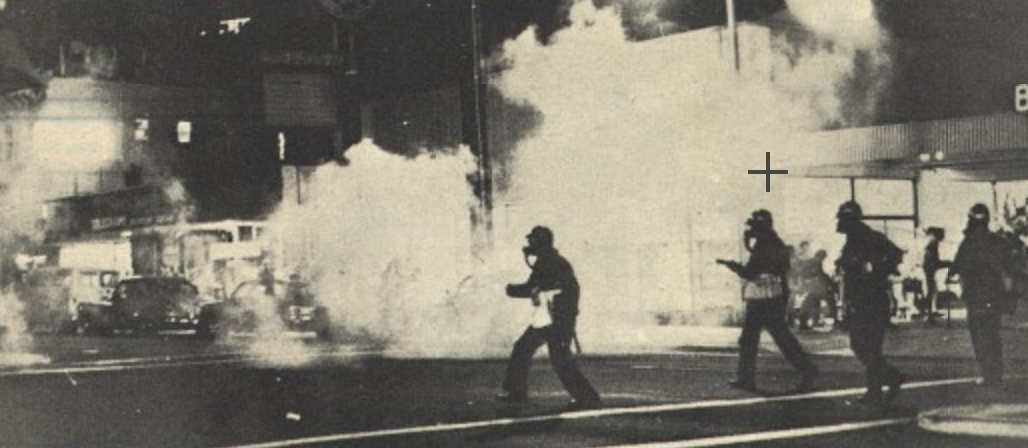












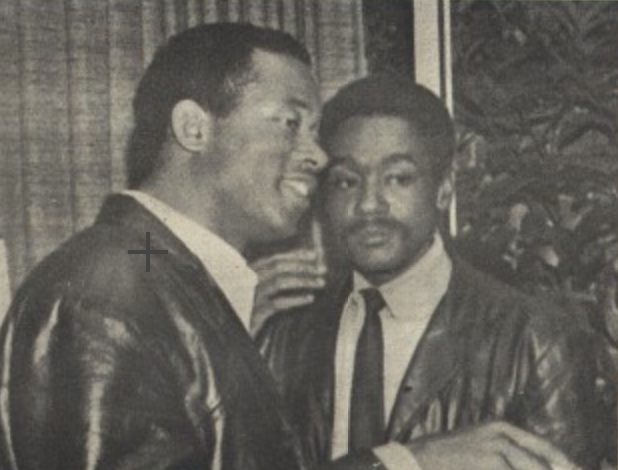
















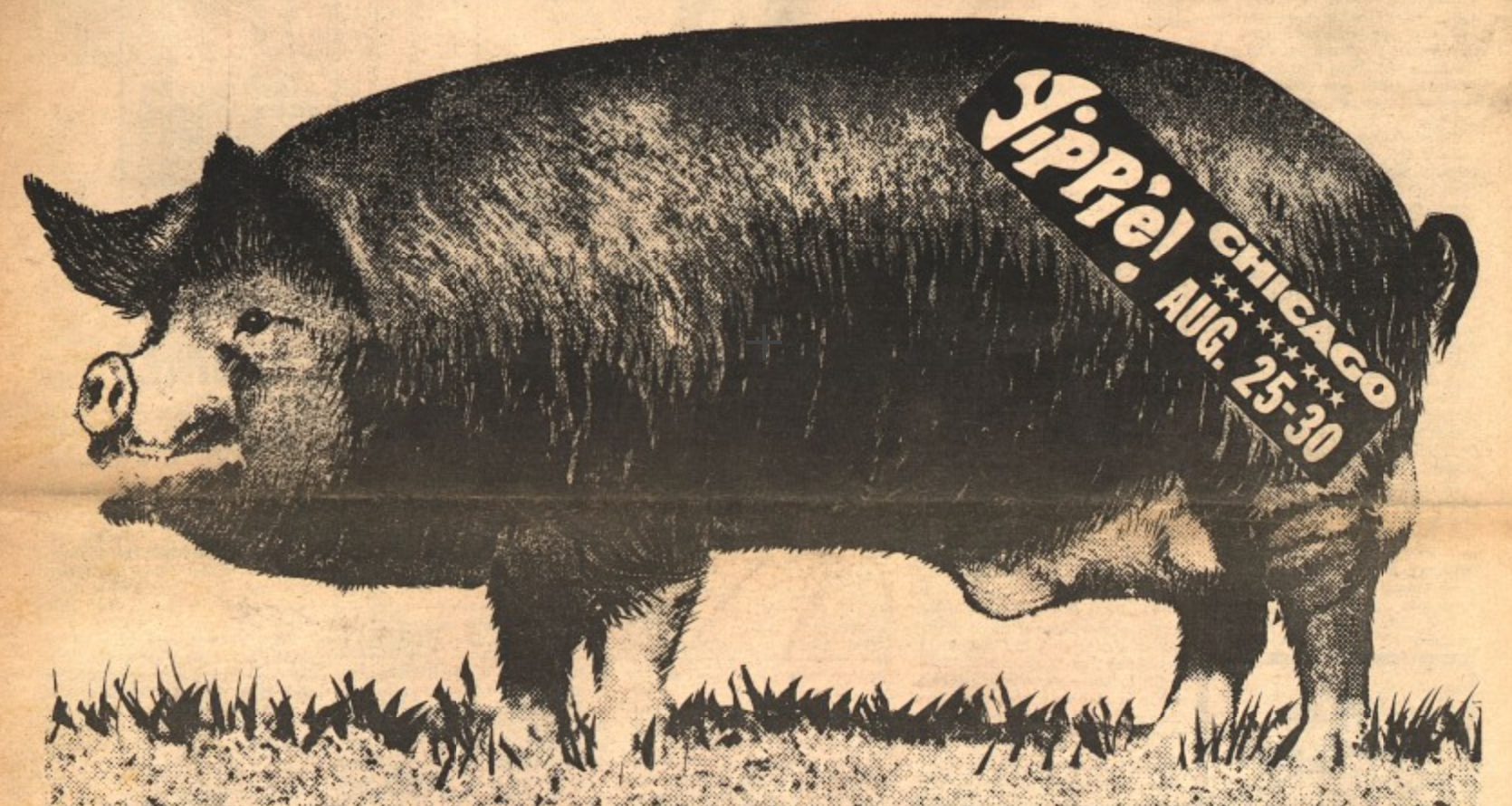









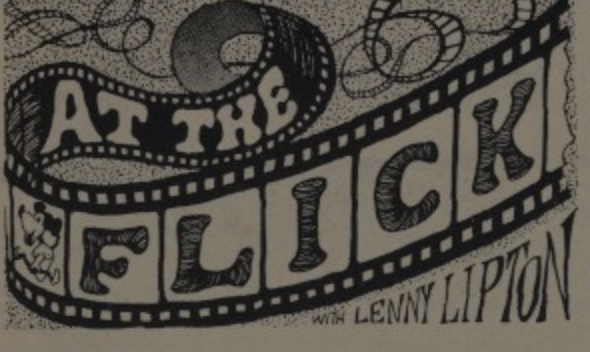










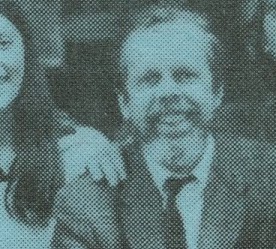

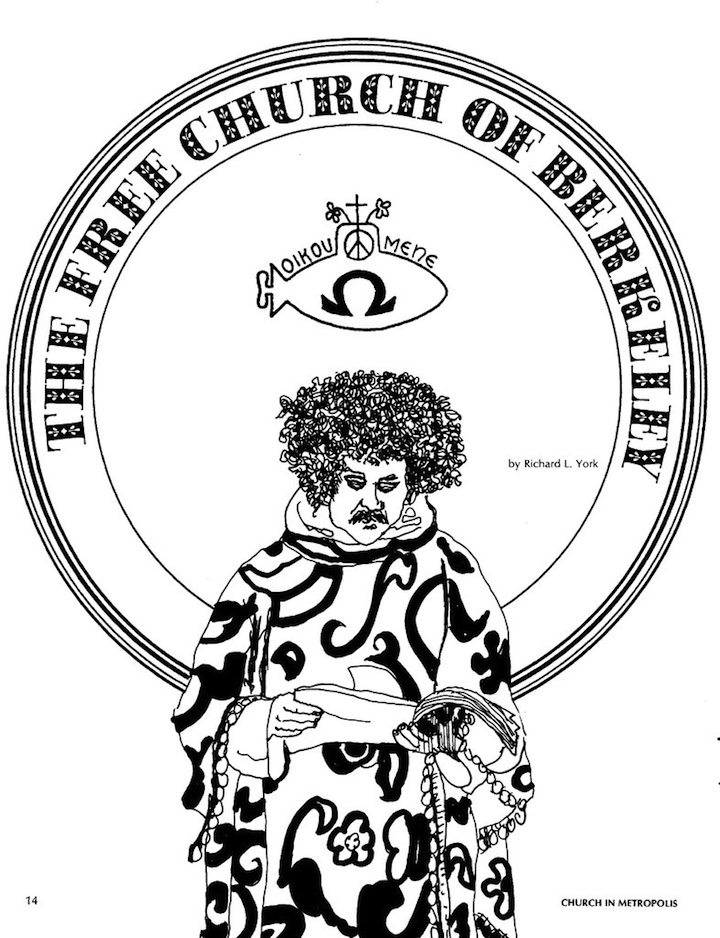


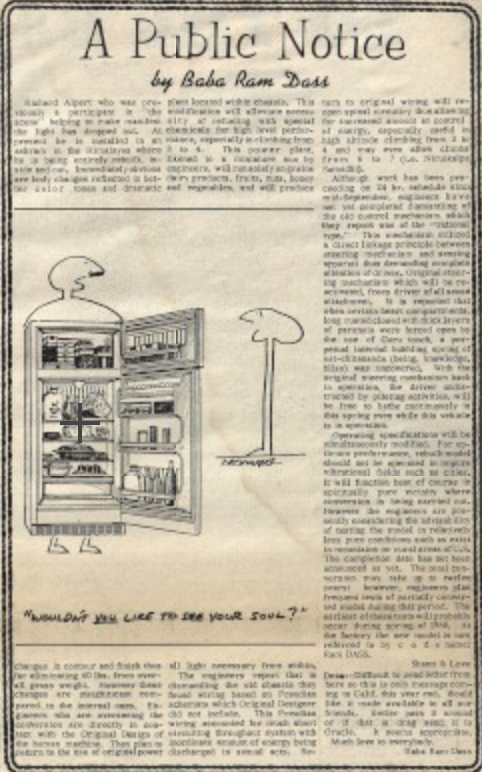
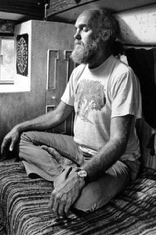










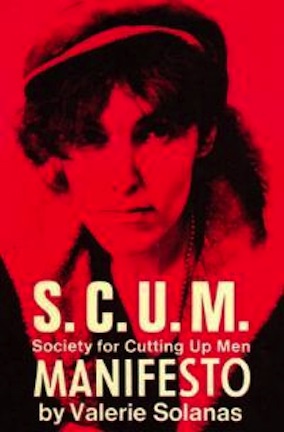
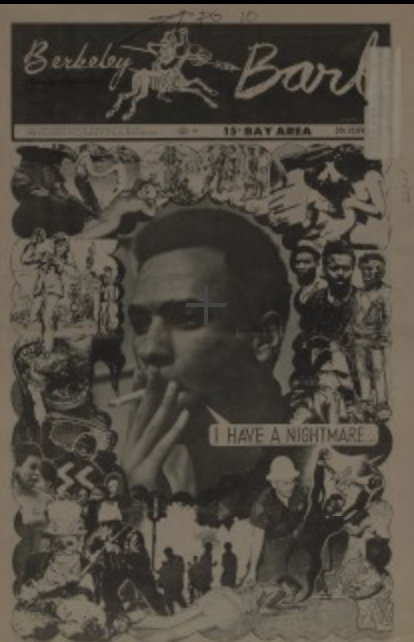











Thank you Tom, this one really brought back a lot of memories, Well Done !
wow. that was a lot to take in. and now, as i often do, i will take a pilgrimage. this time
to neal’s mother’s house
Thank you for all this research and the running commentary on such a tumultuous year! We are still processing all that got started: minority/women’s/gay rights, anti-war and anti-fascist protests, community-led services (public radio, collectives), social justice, sex/drugs/rock-n-roll . . . . Keep up the good work!
p.s. I went to UC Berkeley 1967-1973, lived a few blocks from People’s Park and Telegraph Avenue during most of these years.
Bulwinkle visits the time machine, Rocky. Nice work, Tom. Important, too, I think. Keep digging! M